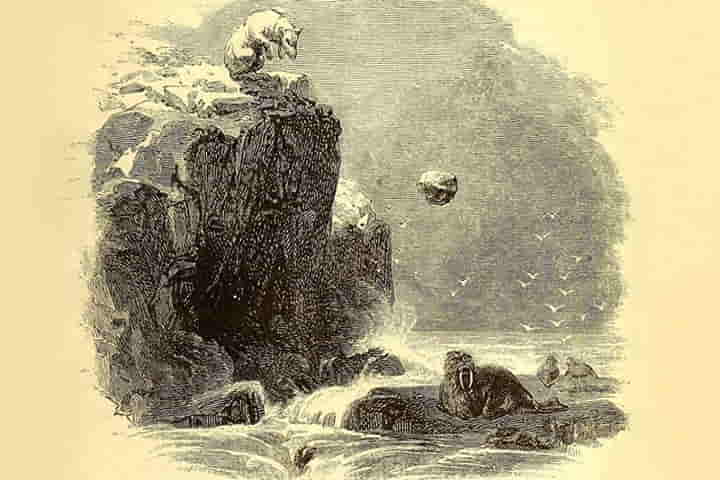There have been several instances of different animals who through their ingenuity use tools to obtain food or water, to groom themselves or others or to communicate or to construct. For example, primates are known to use tools to hunt mammals and fish, make use of sticks to get honey from the honeycombs while the elephants have been seen using branches to swat flies or scratch themselves.
When it comes to polar bears there have not been too many studies on their using any matter or material as tools to their benefit. Way back in 1865, Charles Francis Hall, an Arctic explorer had published an account of an Inuit, which described a polar bear using a rock to attack a walrus. The place was Canada’s Baffin Island. Apart from the account, he also included an engraving showing the bear bashing the prey in his book on his Arctic researches.
According to an article in smithsonianmag.com, this is how he narrates the incident of the bear using rock in the book: “The bear mounts the cliff, and throws down upon the animal’s head a large rock, calculating the distance and the curve with astonishing accuracy, and thus crushing the thick bullet-proof skull.”
The claims about the polar bear’s ability to make use of ice chunks and rocks to smash the skulls of walruses were never taken seriously till now when researchers from Canada have discovered proof to corroborate what was described by the indigenous people.
Also read: Big eaters, Sea otters have to gorge to keep themselves warm in icy waters
Now a study led by Ian Stirling, a biologist at the University of Alberta, Edmonton and the lead author of the study, after going through the Inuit accounts of more than 200 years, suggest that even though such attacks by polar bears may be rare, they do happen. The study which was published in the journal Arctic which is peer-reviewed concludes that “polar bears may occasionally use tools to hunt walruses in the wild.”
Talking about the Inuit described incidents, Stirling told Mindy Weisberger of Live Science: “I have always been impressed with the accuracy and reliability of the observations of animals reported by experienced Inuit hunters, so I thought it was likely the accounts might not just be myths but the result of reporting of actual observations, even though the behaviour itself is likely quite rare.”
As per the accounts of the Inuit the bears pick up ice chunks and rocks and throw them on the heads of unsuspecting walruses.
Walruses, being large marine mammals, are seldom preyed upon because of their size – the males can weigh more than 2,500 pounds – and thick skulls and lethal tusks. Given these characteristics, it is definitely difficult for polar bears to bring them down, states Kristine De Abreu of ExplorersWeb.
For Stirling and his colleagues, the clobbering of walruses by polar bears seems logical. In their study they give the instance of a five-year-old male polar bear named GoGo in a Japanese zoo, who uses objects as tools in order to obtain food. This male is known to use sticks and also throw large tires in order to knock down food which is placed at inaccessible perches. The study stated: “GoGo demonstrated an exceptional and previously undocumented degree of conceptual creativity to facilitate access to a food item hanging from the air.”
Also read: Rodents too help their near & dear ones just like humans
Explaining this behaviour on the part of the bear, Stirling told Ginella Massa of CBC Radio: “The most significant part of this is that a bear is able to look at a situation, think of it in a three-dimensional sense, and then figure out what it might have to do to be successful.”
This is not just one example, there are others. In Alaska, researchers videotaped polar bears in the wild throwing ice chunks at seals. In another account which has been gathered by the United States Geological Survey’s Alaska Science Center Polar Bear Research Project depicts this furry animal sliding a large lump right across the frozen surface to an open hole with the aim of ambushing a prey.
In the past researchers and scientists were not privy to polar bear’s capability of using tools. But with new evidence and proof they suggest this is very much possible in the right circumstances, especially if the predator is faced with a big and formidable foe like the walrus, whom they want to hunt for food.
The study stated: “An occasional adult polar bear might be capable of mentally conceptualizing a similar use of a piece of ice or a stone as a tool.”




















